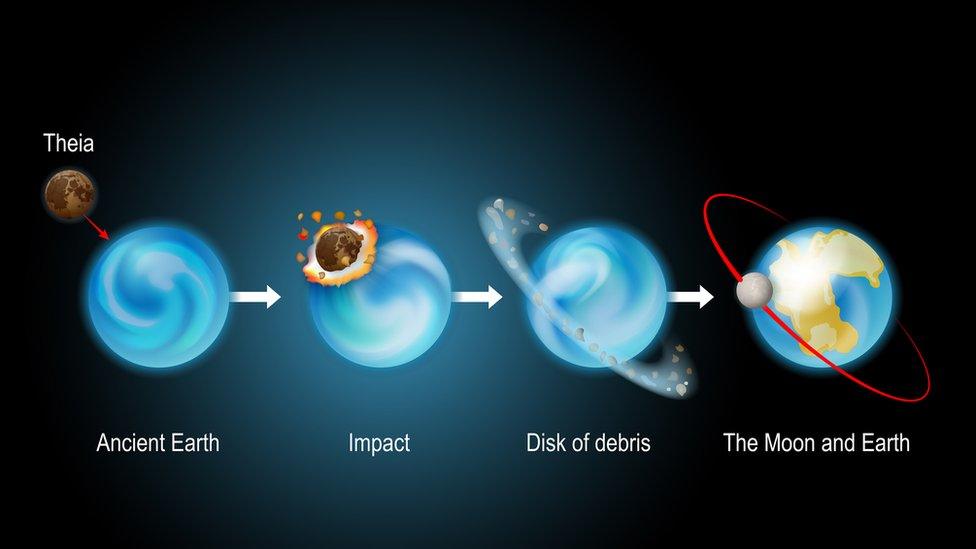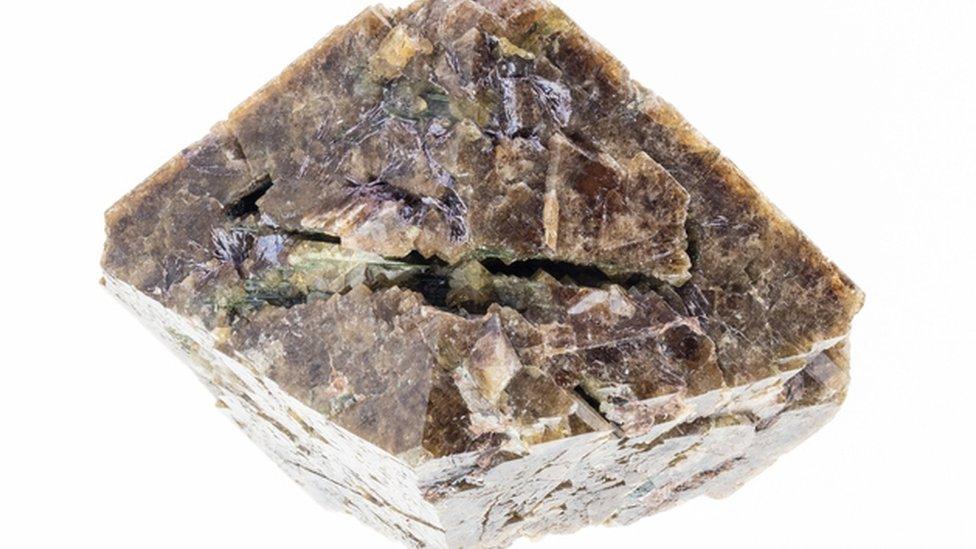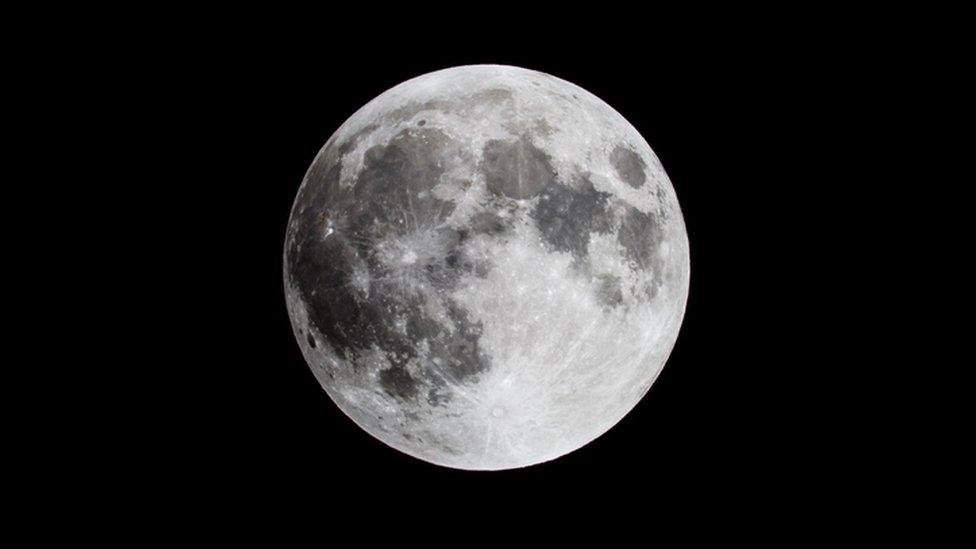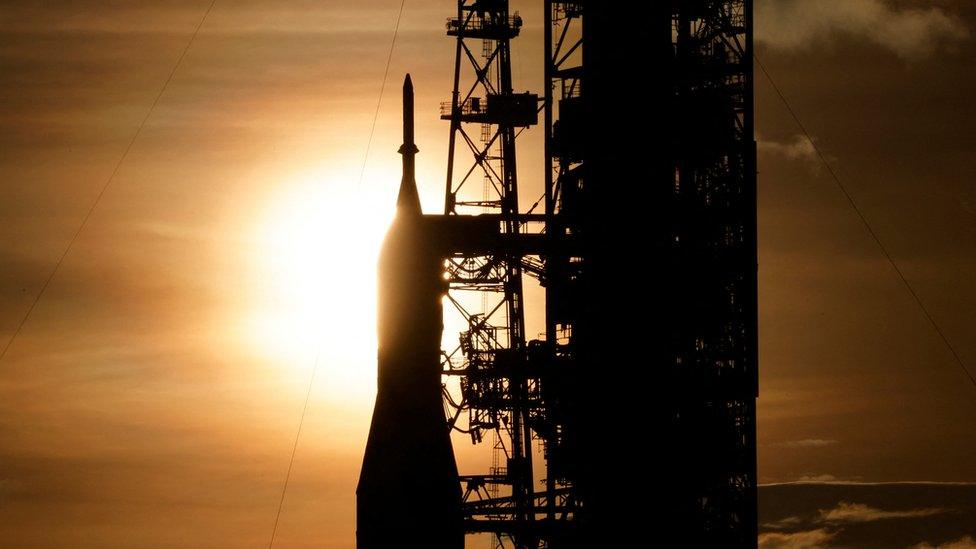The Moon is 40 million years older than scientist previously thought
- Published
- comments

It can be a bit embarrassing if you guess someone's age incorrectly, so imagine being wrong by more than 40 million years.
Scientists studying fragments of Moon rock, gathered the last time humans visited the Lunar surface more than 50 years ago, say they've worked out a more precise way for calculating its age.
Analysing crystals found within the rock, the experts now think Earth's nearest neighbour is about 40 million years older than previously thought, forming more than 4.46 billion years ago - roughly 110 million years after the beginnings of our solar system.
How was the Moon made?

It's believed sometime during the solar system's chaotic early start, a Mars-sized object called Theia slammed into the newly-formed Earth.
The impact blasted magma - hot molten rock - out into space. It then formed a ring of debris orbiting the Earth - a bit like the ring seen around the planet Saturn today.
However, the debris in this ring started to clump together to eventually form the Moon.
Calculating the timing of that event was tricky.
How do you work out how old the Moon is?

Zircon crystals are among the oldest materials found on Earth, Moon and Mars. They are very hard and can survive harsh environments over long periods of time
Using a technique known as atom probe tomography - which looks at the structure of things at an extremely small atomic level - scientists analysed and worked out the age of zircon crystals found inside fragments of Moon rock.
"All the oldest minerals found on Earth, Mars and the Moon are zircon crystals," says the study's co-author Bidong Zhang, a planetary scientist at the University of California, Los Angeles (UCLA).
The zircon crystals - which are very hard and can survive harsh environments over time - formed when the hot magma, created during Earth's impact with Theia, cooled and became solid.
A discovery made half a century later
Highlights from the Apollo 17 mission
During the Apollo 17 mission in 1972 - the last time people walked on the Moon - US astronauts Harrison Schmitt and Eugene Cernan collected more than 110kg of soil and rock samples, which they returned with to Earth to be studied.
The rock containing the zircon was collected in the Taurus-Littrow valley at the south eastern edge of an area on the Moon known as the Sea of Serenity. It's the area of the Moon that looks like its right eye - if you've ever noticed the craters on its surface look a little bit like a face?
"I love the fact that this study was done on a sample that was collected and brought to Earth 51 years ago.
"At that time, atom probe tomography wasn't developed yet and scientists wouldn't have imagined the types of analyses we do today," said Philipp Heck, senior author of the study and a professor at the University of Chicago.

Only once the Moon had formed was life on Earth possible, scientists say
Why is the Moon's age important?
It was only once the Moon had been formed that life on planet Earth was possible.
"The giant impact that formed the Moon was a cataclysmic event for Earth and changed Earth's rotational speed," said Professor Heck.
"After that, the Moon had an effect on stabilizing Earth's rotational axis and slowing down Earth's rotational speed.
"The formation date of the Moon is important as only after that Earth became a habitable planet."
"The Moon helps stabilize Earth's axis for a stable climate," added co-author Zhang.
"The Moon's gravitational pull help shape the ocean's ecosystem. The Moon is inspirational to human cultures and explorations and Nasa and other space agencies see the Moon as a steppingstone for future deep-space explorations."

Further Moon exploration trips are planned
Several space agencies across the world are planning trips to the Moon, including Nasa, which hopes to launch the crewed Artemis II mission late next year.
It will involve astronauts travelling in a capsule around the Moon and testing the route that will be taken by Artemis III, planned for December 2025, which will see astronauts walk on the surface of the Moon for the first time in more than 50 years.
While there, it is planned they will explore the Moon's south pole, an area never visited by humans.
WATCH: What are conditions like on the Moon?
- Published4 September 2022

